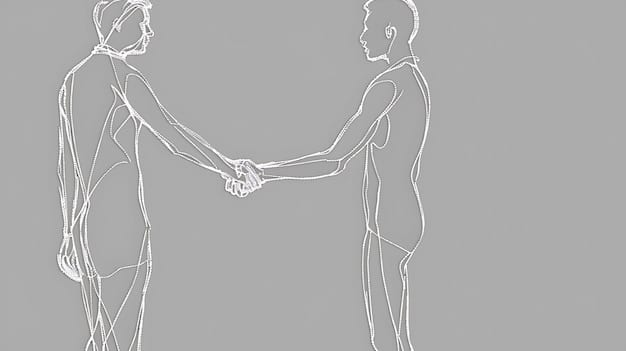Latest Couples Therapy Techniques: What Works in 2025

The landscape of couples therapy is rapidly evolving, with new research in 2025 highlighting the effectiveness of emotionally-focused, attachment-based, and trauma-informed approaches, while data increasingly questions the long-term efficacy of older, less adaptable models focused solely on communication skills.
In a world of constant change, the dynamics of relationships are anything but static. For couples navigating the complexities of modern life, finding effective support can be the cornerstone of a lasting bond. This deep dive into The Latest Research on Effective Couples Therapy Techniques: What Works and What Doesn’t in 2025 explores the cutting-edge approaches reshaping how we understand and heal relational distress, moving beyond outdated methods to embrace what truly fosters connection and resilience.
The Evolving Landscape of Couples Therapy
The field of couples therapy is dynamic, constantly integrating new insights from neuroscience, psychology, and attachment theory. What was considered cutting-edge a decade ago may now be refined or even superseded by more empirically supported methods. In 2025, the emphasis has firmly shifted towards holistic, evidence-based approaches that address not just surface-level conflicts but the deeper emotional patterns sustaining distress. The therapeutic spotlight is now on fostering profound emotional connection and security.
For years, many couples therapies focused primarily on communication skills and conflict resolution. While these are certainly important aspects of a healthy relationship, research now indicates that addressing deeper emotional needs and relational patterns is often more critical for long-term success. The shift reflects a growing understanding that relationship issues are rarely just about “what” is said, but “how” it’s said, and more importantly, the underlying fears, desires, and vulnerabilities that drive interaction.
One of the most significant changes is the integration of diverse theoretical frameworks. Therapists are increasingly drawing from multiple schools of thought to create more tailored and effective interventions. This eclectic yet evidence-based approach acknowledges that no single method works for every couple, and flexibility is key.
Beyond Communication: A Deeper Dive
Historically, much of couples therapy revolved around teaching partners how to communicate better—using “I statements,” active listening, and conflict de-escalation techniques. While these skills are valuable, they often fail to address the core emotional injuries or attachment insecurities that fuel repetitive negative cycles. Effective therapy in 2025 goes beyond surface-level techniques, aiming to transform the underlying emotional landscape of the relationship.
Successful approaches today recognize that communication breakdowns are often symptoms of deeper unmet needs or unresolved emotional wounds. Therefore, merely teaching communication skills without addressing these root causes can be akin to patching a leaky faucet without fixing the plumbing—it might offer temporary relief but won’t solve the fundamental problem.
- Shifting from reactive to proactive intervention.
- Focusing on underlying emotional needs.
- Moving beyond surface-level conflict resolution.
- Emphasizing emotional regulation and co-regulation.
The Role of Attachment Theory
Attachment theory, originally developed by John Bowlby, has become a cornerstone of modern couples therapy. It posits that early childhood experiences with caregivers shape our “attachment styles,” which profoundly influence how we relate to others in intimate adult relationships. Understanding these styles—secure, anxious, avoidant, or disorganized—provides a powerful lens through which to view relational patterns.
In therapy, exploring attachment styles helps couples understand why they react to perceived threats or bids for connection in certain ways. For example, an anxiously attached partner might crave constant reassurance, while an avoidantly attached partner might withdraw when feeling overwhelmed. Recognizing these patterns allows couples to develop empathy for each other’s behaviors, moving from blaming to understanding and creating a more secure base for their relationship.
The integration of attachment theory in therapy helps couples recognize how their individual relational histories play out in their current dynamic. This understanding fosters compassion and allows for the development of new, healthier patterns of interaction, breaking cycles of distress.
Emotionally Focused Therapy (EFT): The Gold Standard Persists
Emotionally Focused Therapy (EFT), pioneered by Dr. Sue Johnson, continues to be a leading empirically supported approach in 2025. EFT is rooted in attachment theory and focuses on identifying and transforming negative interactional cycles that keep couples stuck. It helps partners understand their own and each other’s underlying emotions and unmet attachment needs that drive these cycles.
EFT operates on the premise that relationship distress often stems from unmet needs for secure attachment—a fundamental human need for safe emotional connection. When these needs are threatened, individuals often react with protective behaviors, like criticism or withdrawal, which inadvertently push partners further away, creating a vicious cycle of hurt and disconnection. The therapy guides couples in de-escalating conflict and creating new, more positive interaction patterns.
The primary goal of EFT is to help couples restructure their emotional responses and initiate new, more adaptive interactional sequences. This involves accessing deeper, often unexpressed emotions like fear, loneliness, or longing, and helping partners communicate these vulnerable feelings to each other in a way that fosters empathic responses. It’s about creating a safe space for emotional expression and understanding.
The Three Stages of EFT
EFT is typically divided into three main stages, each building upon the previous one to foster deeper connection and security. These stages guide the therapist and couple through a structured yet flexible process to repair and rebuild their relationship. The progression through these stages is not always linear, but each one serves a distinct purpose in the therapeutic journey.
The first stage, “de-escalation,” focuses on identifying the negative interactional cycle that causes distress and helping partners see how they both contribute to it. The second stage, “restructuring the bond,” involves helping partners express deeper, vulnerable emotions and unmet needs to each other in a way that generates empathy and new, more constructive responses. Finally, the third stage, “consolidation,” helps couples solidify their new ways of interacting and apply them to future challenges.
- De-escalation: Identifying negative patterns and cycles.
- Restructuring: Expressing vulnerable emotions and needs.
- Consolidation: Solidifying new interaction patterns.
- Integration: Applying skills to future relationship challenges.
Why EFT Remains Highly Effective
EFT’s enduring success stems from its ability to target the core emotional experience of a relationship. Rather than just managing symptoms, it aims to heal the underlying wounds and reshape the emotional bond. Research consistently shows high rates of success, with many couples reporting significant improvements in relational satisfaction and reduced distress.
Its strength lies in its emotional depth; it doesn’t just teach skills but facilitates genuine emotional repair. By helping partners understand and respond to each other’s deepest emotional needs, EFT creates profound and lasting changes. It teaches couples to become more emotionally attuned and responsive to one another, fostering a secure base from which they can navigate life’s challenges together.
The Rise of Attachment-Based and Trauma-Informed Approaches
Building on the foundations of EFT, attachment-based and trauma-informed therapies are gaining significant traction in 2025. These approaches recognize that many relational difficulties are deeply intertwined with past attachment injuries or unresolved traumas, both individual and relational. They emphasize creating a safe environment where these profound experiences can be processed and healed within the context of the relationship.
Trauma-informed couples therapy acknowledges that trauma, whether from individual experiences or within the relational dynamic itself (e.g., infidelity, chronic conflict), can significantly impact a couple’s ability to connect. It employs specific techniques to help partners regulate their nervous systems, process traumatic memories, and rebuild trust and safety. The focus is on understanding how past hurts manifest in the present relationship and developing healthier coping mechanisms.
These approaches are particularly valuable for couples where one or both partners have experienced significant trauma or exhibit insecure attachment styles that lead to recurring patterns of distress. By addressing the root cause of these patterns, therapy can facilitate deeper healing and create a more resilient relational bond. It’s about more than coping; it’s about transformation.

Integrating Internal Family Systems (IFS) with Couples Therapy
Internal Family Systems (IFS), traditionally an individual therapy, is increasingly being integrated into couples work. IFS views the mind as composed of various “parts” – fragmented aspects of the personality formed through life experiences. In couples therapy, IFS helps partners understand their own internal parts (e.g., “the angry part,” “the insecure part”) and how these parts interact with their partner’s parts.
This approach helps de-pathologize behavior, fostering self-compassion and compassion for one’s partner. Instead of labeling a partner as “angry” or “withdrawn,” IFS helps couples understand that these are protective parts trying to manage inner pain or fear. By accessing the “Self” – the core of compassion and wisdom within each person – partners can relate to their own parts and their partner’s parts with greater understanding and acceptance. This method facilitates profound understanding and shifts in relational dynamics.
It allows couples to move beyond blame and towards a shared understanding of their internal landscapes, which then facilitates more authentic and compassionate interaction. By working with their own parts, individuals can show up more fully and authentically for their partner, reducing conflict and fostering deeper intimacy.
Trauma-Informed Skills for Couples
For couples affected by trauma, specific skills are crucial. These include:
- Pacing and containment: Therapists help couples manage overwhelming emotions and prevent re-traumatization.
- Dual attention: Helping clients focus on both the internal experience of trauma and their external, present-day environment to promote regulation.
- Somatic experiencing: Working with body-based sensations to release stored trauma and reduce physiological arousal.
- Building secure attachment: Actively fostering a sense of safety and predictability within the relationship to counteract past insecurities.
These skills, when integrated into couples therapy, enable a nuanced and sensitive approach to healing, recognizing the profound impact of past experiences on current relational patterns.
Behavioral and Cognitive Approaches: Refinements and Limitations
While the focus in 2025 is increasingly on emotional and attachment-based work, behavioral and cognitive approaches still hold a place, albeit with significant refinements. Early forms of behavioral couples therapy (BCT) primarily focused on skill-building, such as active listening and problem-solving, often without delving into underlying emotional dynamics. Cognitive Behavioral Therapy (CBT) for couples aimed to identify and restructure negative thought patterns influencing relational distress.
However, research in 2025 has highlighted the limitations of these approaches when used in isolation. While they can be effective for teaching specific skills or managing acute conflicts, they often fall short in addressing deeper emotional wounds or systemic relational patterns. The lack of emphasis on emotional processing and attachment needs can lead to temporary improvements that don’t always translate into lasting relational transformation.
Modern applications of BCT and CBT in couples therapy are increasingly integrated with emotional and attachment-based principles. They are seen as complementary tools, used to reinforce new patterns of interaction once deeper emotional work has begun to create relational change. This refinement acknowledges that behavior and cognition are often symptoms of underlying emotional states and relational dynamics.
Integrative Behavioral Couples Therapy (IBCT)
Integrative Behavioral Couples Therapy (IBCT) represents a significant evolution in behavioral approaches. Unlike pure BCT which primarily focuses on changing behavior, IBCT emphasizes both change and acceptance. It helps couples understand that some differences or perpetual problems may not be resolvable, and acceptance of these issues can actually foster intimacy.
IBCT focuses on helping partners accept each other’s vulnerabilities and differences, while simultaneously working to change patterns that create distress. It involves identifying “themes” or “triggers” that lead to conflict and helping couples respond to these triggers with greater understanding and compassion. This acceptance-based component adds a crucial emotional dimension that traditional BCT often lacked.
The core tenets of IBCT include:
- Unified detachment: Helping couples gain an objective perspective on their negative interaction cycles.
- Empathic joining: Encouraging partners to express their pain and vulnerability in ways that promote compassion from their partner.
- Tolerance building: Developing strategies for partners to cope with and accept aspects of their relationship that are difficult to change.
- Behavior exchange: Reintroducing positive behaviors and interactions to improve daily relational experiences.
When Behavioral Approaches Fall Short
Even with refinements, purely behavioral or cognitive approaches may fall short in situations where:
- There are deep-seated attachment injuries.
- Unresolved trauma impacts relational dynamics.
- Partners struggle with emotional expression or regulation.
- Core values or fundamental needs are consistently unmet.
In these cases, a therapeutic approach that delves deeper into emotional processing and attachment patterns is often more effective. Behavioral strategies can then serve as supportive tools once the core emotional issues are addressed.
What Doesn’t Work (or Is Less Effective) in 2025
While the field of couples therapy has advanced significantly, some older approaches or isolated techniques are proving less effective in today’s complex relational landscape. In 2025, therapies that focus solely on surface-level symptom management without addressing deeper emotional and attachment needs are generally considered less impactful for lasting change. Approaches that prioritize individual blame or lack a systemic understanding of relational dynamics also tend to fall short.
“Skills-Only” Approaches
As mentioned, approaches that solely teach communication or problem-solving skills, without facilitating emotional processing or addressing underlying attachment needs, often yield limited long-term results. While skills are important, they are rarely sufficient to transform deeply ingrained relational patterns driven by fear, insecurity, or past wounds. Couples may learn to “talk better” but still feel emotionally disconnected or misunderstood.
Therapy That Ignores Attachment or Trauma
For many couples, relational distress is a manifestation of insecure attachment patterns or unresolved trauma. Therapy that fails to acknowledge and work with these deeper issues often misses the mark. It’s like trying to fix a leaky roof without understanding the structural damage beneath. Without addressing the root causes, symptoms may persist or reappear in different forms.
Ignoring these underlying factors can also inadvertently retraumatize individuals if discussions are not handled with sensitivity and a deep understanding of nervous system regulation. A trauma-informed lens is now considered essential for ethical and effective couples work.
Therapy Focused on Blame or Pathologizing One Partner
Effective couples therapy views the relationship as the client, understanding that both partners contribute to dynamics, even if one seems more “problematic” than the other. Approaches that pathologize or assign blame to one partner undermine the sense of shared responsibility and create defensiveness, hindering progress. Authentic healing requires a safe space free from judgment.
Addressing Specific Challenges: Technology, Infidelity, and Life Transitions
Modern relationships present a unique set of challenges that contemporary couples therapy must address. In 2025, issues like digital distraction, the aftermath of infidelity, and the stresses of major life transitions are common drivers for seeking therapy. Effective techniques are adapting to provide targeted support for these complex situations.
The Impact of Technology and Digital Connection
Technology, while offering new ways to connect, can also create distance and misunderstanding within relationships. Constant digital distraction, social media comparisons, and cyber-infidelity are increasingly common issues discussed in therapy. Effective approaches help couples set boundaries around technology, prioritize real-life connection, and understand how digital habits impact their emotional intimacy.
Therapists now explore how screen time affects presence and engagement within the relationship. They guide couples in establishing “tech-free zones” and developing shared activities that foster genuine connection. This includes understanding the subtle ways technology can erode trust or create feelings of neglect.
Healing from Infidelity (Rebuilding Trust)
Infidelity is one of the most painful experiences a couple can face, often shattering trust and creating profound emotional wounds. Therapy for infidelity in 2025 focuses on a multi-stage process of healing. This includes:
- Immediate crisis management: Managing intense emotions and ensuring safety.
- Understanding the “why”: Exploring the individual and relational factors that contributed to the infidelity, without excusing the act.
- Processing grief and trauma: Acknowledging and validating the pain experienced by both partners.
- Rebuilding trust: A long and arduous process that requires consistent transparency, accountability, and empathy from the unfaithful partner, and the willingness to take risks from the injured partner.
- Forgiveness and moving forward: Deciding whether and how to rebuild the relationship, or to separate with mutual respect.
This process is delicate and requires a highly skilled therapist who can hold space for immense pain while guiding the couple towards potential reconciliation or a healthy separation.

Navigating Life Transitions Together
Major life transitions—such as marriage, parenthood, career changes, moving, or retirement—can place significant stress on a relationship. These periods often necessitate a re-negotiation of roles, expectations, and identities. Couples therapy helps partners navigate these shifts by:
- Improving communication around changing needs.
- Adapting roles and responsibilities.
- Managing stress and supporting each other through uncertainty.
- Maintaining intimacy and connection amidst new demands.
The goal is to help couples evolve together, using transitions as opportunities for growth rather than sources of perpetual conflict. It’s about building resilience as a unit, ensuring that the relationship remains a source of strength during times of change.
The Future of Couples Therapy and Training
As we look beyond 2025, the field of couples therapy is poised for further innovation, driven by advancements in neurobiology, technological integration, and a continued emphasis on cultural humility and diversity. The future of effective couples therapy lies in personalized, adaptable, and deeply empathic approaches that honor the unique complexities of each relationship.
Personalized and Adaptive Treatment Models
The “one-size-fits-all” model of therapy is increasingly being replaced by highly personalized treatment plans. Future couples therapy will likely involve even more sophisticated assessments to identify a couple’s specific needs, attachment patterns, and underlying issues. Therapists will be trained to fluidly integrate various evidence-based techniques, adapting their approach based on the couple’s progress and evolving needs.
This precision-based therapy will leverage data-driven insights to inform interventions, ensuring that therapeutic efforts are maximally effective. The emphasis will remain on fostering a strong therapeutic alliance, as this foundational element transcends specific techniques.
Integration of Neuroscience and Biofeedback
Advancements in neuroscience are continually deepening our understanding of how relationship stress impacts the brain and body. Future couples therapy may increasingly integrate biofeedback and neurofeedback tools to help partners regulate their nervous systems, reduce physiological arousal during conflict, and promote a sense of calm and safety. Understanding the neural underpinnings of attachment and connection will further refine interventions.
This integration could lead to more direct and efficient ways of helping couples shift out of fight-flight-freeze responses and into states of calm connection. It’s about leveraging scientific understanding to enhance emotional regulation and relational harmony.
Cultural Competence and Diversity
As societies become more diverse, the importance of cultural competence in couples therapy cannot be overstated. Effective therapists in the future will possess a deep understanding and appreciation for how cultural background, ethnicity, sexual orientation, gender identity, and socioeconomic status influence relational dynamics. Training programs are increasingly emphasizing the importance of cultural humility and the ability to adapt therapeutic interventions to various cultural contexts, ensuring relevance and effectiveness for all couples.
This includes understanding how cultural narratives around love, marriage, and family impact expectations and conflicts within a relationship. A culturally sensitive approach ensures that therapy resonates with the couple’s lived experience, fostering trust and engagement.
| Key Area | Brief Description |
|---|---|
| 💖 Emotional Focus | Focus on core emotions and attachment needs, shifting from surface conflicts. |
| 🔗 Attachment-Based | Utilizes attachment theory to understand relational patterns and insecurities. |
| 🧠 Trauma-Informed | Acknowledges and addresses past traumas impacting current relationship dynamics. |
| 🚫 What Doesn’t Work | Purely “skills-only” or blame-focused approaches often fall short for lasting change. |
Frequently Asked Questions About Couples Therapy in 2025
▼
In 2025, Emotionally Focused Therapy (EFT) remains consistently identified as one of the most effective and empirically supported approaches. Its strength lies in addressing underlying emotional patterns and attachment needs rather than just surface-level conflicts, leading to profound and lasting relational transformation.
▼
Couples therapy has evolved from primarily focusing on communication skills to integrating deeper emotional, attachment-based, and trauma-informed approaches. The shift emphasizes understanding and restructuring core relational dynamics and emotional responsiveness, moving beyond just teaching superficial tools for conflict resolution.
▼
Absolutely. Unresolved individual or relational trauma can significantly impact attachment styles, communication, and overall intimacy. Trauma-informed couples therapy specifically addresses these imprints, creating a safe space to process past hurts and develop healthier relational patterns, fostering healing and resilience within the partnership.
▼
While valuable, “skills-only” therapy often falls short because it doesn’t address the underlying emotional injuries or attachment insecurities that drive relational distress. Couples may learn communication techniques but still lack deeper emotional connection or understanding of their recurring negative cycles, limiting long-term success.
▼
Technology introduces new challenges like digital distraction, social media comparisons, and cyber-infidelity. Modern couples therapy addresses these issues by helping partners set boundaries, prioritize real-life interaction, and understand how digital habits can impact emotional intimacy and trust, fostering healthier digital-life balance.
Conclusion
The landscape of couples therapy in 2025 is characterized by a profound shift towards understanding and transforming the deep emotional and attachment patterns that define relationships. Approaches like Emotionally Focused Therapy (EFT) continue to demonstrate remarkable effectiveness by helping partners navigate their core emotional needs and reshape their patterns of interaction. Simultaneously, the growing integration of trauma-informed care and nuanced behavioral techniques like IBCT underscores a commitment to holistic healing. As we move forward, the emphasis remains on fostering genuine connection, building resilience, and equipping couples with the tools to navigate the inevitable complexities of life together, ensuring that therapy remains a powerful avenue for relational growth and profound intimacy.





